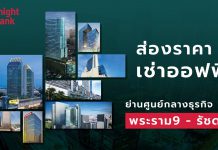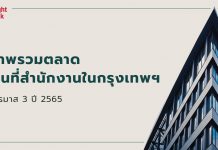Mr. Marcus Burtenshaw, Executive Director and Head of Occupier Services and Commercial Agency (OSCA), Knight Frank Thailand, said that “as 2021 began, all key indicators showed that the market is softening and moving in favour of tenants. We have seen increased vacancy rates across the city and throughout all grades. Landlords have also become increasingly flexible, offering improved incentives such as rent-free, half-rent and rental discounts for new tenants and even for existing tenants upon lease renewal. If your firm has a lease expiry coming up in the next 12 months, we strongly recommend speaking with one of our experts to see how we can help you to ensure that your future accommodation costs are aligned with the market outlook.”
Office Property Market Indicators

Economic Overview
The Thai economy contracted by 2.6% Y-o-Y in Q1 2021. Nevertheless, this marks the second consecutive quarter of lessening decline in GDP. The main contributing factors to the improvement include the continued rise of agricultural production, recovery of non-agricultural production, acceleration of domestic investment, rise of government final consumption and improvement of exports of goods.
Government consumption expenditure increased by 2.1%, close to the 2.2% increase recorded in the previous quarter. Compensation of employees, purchases from enterprises and abroad, and social transfers in kind increased by 1.2%, 5.7%, and 2.0%, respectively. On the private sector side, consumption expenditure fell by 0.5% following a 0.9% growth in the previous quarter.
Private consumption was strongly impacted by the resurgence of the COVID-19 pandemic towards the end of 2020. Total investment expanded by 7.3%, recovering from a 2.5% contraction in Q4 2020. Private investment increased for the first time in over 5 quarters, rising by 3.0% because of the expansion of investment in machinery and equipment. On the other hand, public investment increased by 19.6%. Both public investment in construction and machinery and equipment expanded by over 10% due to the progression of large infrastructure projects. Exports and of goods and services dropped by 10.5%, improving from a 21.5% contraction in the previous quarter.
Merchandise exports grew by 3.2% following increase in global demand for agricultural products and electronic products and appliances such as air-conditioners and refrigerators. However, service receipts continued to fall, dropping by 63.5% as the number of foreign tourist arrivals remained limited. In comparison, imports of goods and services expanded by 1.7%. Merchandise imports rose by 6.4%, driven by imports of both consumer and capital goodsOn a positive note, the Business Sentiment Index (BSI) in March increased to 50.1, exceeding the 50-threshold for the first time since May 2019.
This implies that business confidence has improved because a significant number of respondents stated that their business sentiment this month is higher than in the previous. The BSI increased as sentiments improved for almost all components, especially for order books and production sub-indices. In addition, the 3-month expected BSI was recorded at 54.1. For businesses in non-manufacturing sectors, the index rose above the 50-threshold for the first time since the COVID-19 outbreak.
Figure 1
Bangkok Office Supply
Sq m

Supply
Based on Knight Frank Thailand Research, in Q1 2021, total supply of office space in Bangkok increased to 5.42 million sq m as one new building with a net leasable area of 24,000 sq m was completed. In 2020, total supply increased by 179,500 sq m for the full year. This is the greatest level of annual supply increase recorded over the past decade.
Figure 2
Bangkok Office Annual Net Supply Chang
Sq m

Future Supply
From Q2 to Q4 2021, another 348,600 sq m of office space is expected to be added to the market, an addition which will increase total supply by 6% if there are no building withdrawals or construction delays. Around 128,400 sq m or 37% of the projected new supply during this period will be added to the CBD.
Over the past 5 years, new supply was added at a approximate rate of 154,000 sq m per year. In comparison, if launches in Q2 2021 to 2026 do proceed as planned, the Bangkok office market supply will grow by 1.59 million square meters in total or by an average of 277,400 sq m per year (excluding withdrawals). New supply is skewed towards the earlier years as around 985,700 sq m of the new additions is projected to be completed by 2023. This will place even stronger downward pressure on both rents and occupancy over a short period of time unless demand picks up rapidly. Even with COVID-19-related construction delays and a rise in withdrawals of obsolete stock that could counteract the effects of a probable oversupply in the market, the market imbalance will not likely be corrected in the short term.
Figure 3
Bangkok Office Future Supply
Sq m

Demand
Leasing activity picked up somewhat as total take up in Q1 2021 increased by 34% Q-o-Q to 50,200 sq m. This amount is still below the 10-year average of 66,700 sq m of take up per quarter. In 2020, around 33% of total leasing activity was due to leases generated by new and refurbished properties, an increase from 21% recorded last year. The level last year is in line with the 5-year average of 32%, indicating that although some current and potential tenants are acting more conservatively on office relocation or expansion plans, many still have a strong preference for new and refurbished properties.
Along with limited leasing activity, 77,400 square meters of space was returned to the market, a slight improvement from the 79,800 sq m vacated in Q4 2020. Net absorption also improved to -26,600 sq m from -42,700 sq m in Q4. For the full year 2020 however, a net 121,000 square meters of space was returned to the market – A 10-year record low. In contrast, supply grew by 179,500 sq m over the same period, indicating that the gap between supply and demand has widened even further.
Consequently, total occupied space declined by 0.6% Q-o-Q to 4.57 million sq m. The effects of COVID-19 continued to subdue the economy, causing many companies to reduce their real estate footprint. Some firms, especially those from the hard-hit service sector, have shut down operations and exited the market entirely. The growth in enquiries to sublet office space remained a prominent feature in Q4 due to the need for greater lease flexibility, reduced rents, and fitted out space. Although this practice had been highly restricted in the past, a greater number of landlords were open to subletting when faced with the possibility of current tenants vacating space with low prospects for securing a favorable replacement. In addition, some landlords began offering to lease out space partially or fully fitted out to the specifications of new tenants, providing that it is financially feasible to do so. These landlords have recognized that the significant capital expenditure required is an obstacle for relocating tenants.
Figure 4
Bangkok Office Supply – Demand Dynamics
Sq m

Reflecting the market slowdown, the market occupancy rate dropped by 0.9% points to 84.3%. In comparison, the 10-year average occupancy rate stands at 90.0%. All grade segments continued to underperform their long-term averages. On an annual basis, all properties by grade were strongly impacted by the pandemic, as the occupancy rate fell by 5.4% points for grade A, 6.7% points for grade B and 4.2% points for grade C.
Occupancy levels fell both quarterly and annually across all sub-markets tracked with the exception for Silom – Sathorn – Rama IV; The occupancy rate in this area increased by 0.1% points Q-o-Q but fell by 3.5% points Y-o-Y. The market occupancy rate declined by 5.0% points Y-o-Y for CBD properties and 6.7% points Y-o-Y for non-CBD properties. Ploenchit – Chidlom – Wireless is the area with the highest occupancy rate, which is at 89%, despite experiencing a 5.6% point drop in occupancy from the level in Q1 2020.
Rental Rates
The average asking rent fell both on a quarter and annual basis, dropping by 0.7% Q-o-Q to 792 baht per sq m per month. After sustained downward pressure such as the drop off in the demand, tenants vacating space and increased competition from new properties, an increasing number of landlords have elected to decrease their asking rents to attract new tenants. Most landlords have kept their asking rents constant but provide greater room for negotiation. In some leasing deals, the effective rate is up to 30% lower than the asking rent. The average asking rent is now down 0.7% yearly, far below the positive 3.8% average annual growth rate experienced over the past decade.
Figure 5
Bangkok Office Average Asking Rent by Grad
Baht per sq m per month

Table 1
Bangkok Office Average Asking Rent by Grade
Baht per sq m per month

For the entire CBD, the average asking rent fell by 0.8% Q-o-Q. Reflecting this fact, rents declined on a quarterly basis for all 3 CBD districts tracked. On an annual basis, only Silom – Sathorn – Rama IV experienced positive rental growth as the average asking rent is still up 0.6%. The average asking rent for non-CBD districts is down 0.3% Q-o-Q but still up 0.1% Y-o-Y. Bangna – Srinakarin is the only area across Bangkok that experienced positive rental growth both quarterly and annually. However, this due to a new property priced in the 700-baht range and the area’s limited supply base rather than an increase in asking rates of existing properties.
Table 2
Bangkok Office Sub-Market Indicator

Review & Outlook
The Bangkok Office market continued to move away from its cyclical peak as occupancies fell and asking rents declined for most sub-markets, progressively shifting the market equilibrium in favor of tenants. A tenants’ market has definitively emerged in Q1 2021 and is expected to sustain its momentum given the relatively large supply pipeline, especially during the upcoming 3 years. The sudden and steep decline in demand coupled with possible future supply glut is a major cause for concern going forward. As we projected, landlords have started to yield to the downward pressure and dropped their asking rate to secure tenancies. Even for many properties at which the asking rent has been kept constant, landlords compete on both rent and non-monetary incentives such as greater flexibility in negotiation and lease terms, and longer rent-free periods, leading to lower net effective rents. If supply continues to outpace demand, negative annual rental growth rates over the next 3 years are likely to continue.
2020 was marked by several unexpected and unprecedented market movements due to COVID-19. The pandemic brought about “the largest workplace experiment conducted to date,” in which many companies responded by implementing remote working concepts in some form or another and to varying levels of success. This trend has continued in Q1 2021 and has become even more pronounced following the 3rd wave of COVID-19. It is estimated that 60% to 70% of employees in companies that require office space are now working from home. Based on the results thus far, remote work is likely here to stay, but it remains to be seen how much of it will be permanent, and how this will translate into demand for office space. So far, it seems that most companies that successfully adopted remote working policies will continue to do so, but likely to a limited extent.
This most likely means that the future workplace will be defined by a combination of core + flex space and remote working. As a result, we do not anticipate massive decreases in demand for office space in the medium to long term. In fact, some of the 1,000+ sq m deals transacted over the past year have been done by companies that have 80% to 100% of their staff working offsite during the same period. This signals that these companies still view the office space as an essential component to their business operations. Per Knight Frank’s second edition of the (Y)OUR SPACE report, which has compiled findings from our latest survey of almost 400 global occupiers following COVID-19, 27% of respondents believe that Covid-19 will influence their real estate strategy forever, but when the sample is limited to those respondent companies whose global headquarters are within Asia Pacific, this number falls to just 12%.
The next few years will present a challenge for office market landlords. No longer are the policies and approaches widespread in a seller’s market relevant given today’s circumstances. However, there are still opportunities to secure tenancies at office buildings that can be adapted or built to cater to the shifted demand. It is clearer now than ever that the office is much more than a physical space designated for work; flexibility, talent retention and experiences related to such factors as the environment, safety, and wellbeing matter as well. Just 14% of respondents in (Y)OURSPACE believe that it is their sole responsibility to make the workplace safer going forwards. The remaining 86% expect their landlord to be accountable to some extent, whether it be by implementing more rigorous building cleaning regimes or adopting facial recognition technology
Figure 6
Bangkok Office Rental Cycle




















